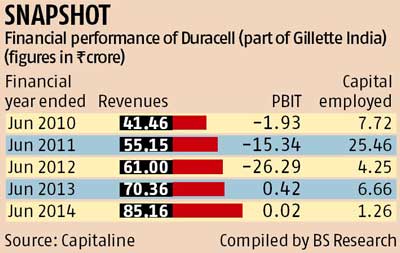The decision of the world's largest consumer goods company Procter & Gamble (P&G) to sell its Duracell battery business will impact India, among the few markets where disposable, non-rechargeable alkaline batteries are still used. This is the mainstay of the Duracell business, which gives P&G almost $2 billion (or Rs 12,000 crore) in revenues globally. Some of the other key markets where where disposable, non-rechargeable alkaline batteries are used include China, Singapore and Indonesia.
A divestment by P&G will mean that it will exit a key category. In India, the disposable, non-rechargeable alkaline battery segment is four-five per cent of the 2.62 billion unit dry cell battery market. The balance is made up of the carbon-zinc variety. The rechargeable battery segment is negligible in India. But while carbon-zinc batteries constitute 95-96 per cent of the overall dry cell battery market in India, their price points are a third of alkaline batteries. Thanks to being priced three times to that of carbon-zinc, alkaline batteries are therefore considered premium and profitable.
Analysts estimate that Duracell has almost a 70 per cent share of the alkaline battery segment in India. Eveready Ultima, its rival, has a 20 per cent share. Also, its steep pricing restricts Duracell to largely urban households, who put these batteries into small electronic gadgets from toys to remote controls, recording devices and digital cameras.

When announcing Duracell's separation yesterday, P&G's global Chief Executive Officer A G Lafley said the business had attractive operating profit margins with a history of strong cash generation.
In India, the Duracell business, which gave P&G's subsidiary Gillette India, almost five per cent of its revenues for the June 2014 ended financial year, recorded its second straight year of profit before interest and tax for the period under review after three years of operating losses. (See chart)
The company recently raised prices of Duracell by 10 per cent, increasing the per unit price point from Rs 30 to Rs 33. Rival Eveready is also said to be contemplating a price hike of 20 per cent on its Ultima brand, taking it from Rs 25 to Rs 30 per unit.
While P&G's total capital employed on its battery business came down 81 per cent to Rs 1.26 crore for the financial year ended June 2014, it had pumped nearly Rs 7 crore in previous financial year and Rs 4.25 crore in the year before that. For the financial year ended June 2011, P&G had employed Rs 25 crore in terms of capital for its battery business.
P&G has said the reason for the divestment of its battery business was linked to its desire to focus on core segments such as personal care, laundry and oral care. This came close on the heels of its August announcement to shed up to 100 non-core brands. That process has been set into motion with the proposed sale of Duracell.

)
